Sightseeing Tour
Tour through the historical city
Town Hall and Market Square
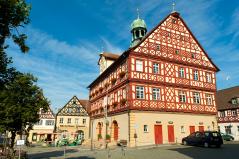
The town hall, today the symbol of the town – suffered under two town fires which raged through Bad Staffelstein in 1473 and 1684. However, large parts of the ground floor walls from the late middle ages are still preserved. The building we see today was erected after 1685 according to the plans of master builder Jacob Pless and carpenter Adam Kuntzelmann. On the ground floor, the town weighing house, sales stalls for bread and meat and a general store were located. The great council chamber, an adjoining room, the kitchen and the dance hall were on the first floor. The weavers and linen weavers used the floor above that.
On the first floor, a wall painting with the town crest – St George over staggered stone – and an inscription recall the conferment of the right to hold a market in 1130. From the high tiled roof, a spire tower with a clock emerges, whose face is surrounded by vines and two floating angels. In the tympanum, the crest of the Bishopric of Bamberg can be seen – with lion and slanting bar.
The market square, laid out in the middle ages, achieved its current scale during the 16 th and 17 th centuries. The market fountain is crowned by one of the most popular saints of the baroque period, Saint John of Nepomuk. Behind the town hall, on the corner of the market square and Bahnhofstraße, you will find the memorial to Adam Ries(e), born in 1492 in Staffelstein. The proverbial master of mathematics is depicted with a pupil. The memorial was dedicated on the 450 th anniversary of his death in 2009.
St. Kilian Town Parish Church
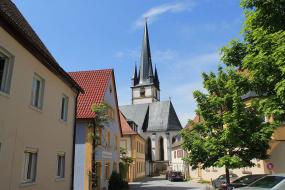
It is the oldest construction in Bad Staffelstein. The oldest parts of the wall are from the 13 th or 14 th century. After the town fire in 1473, the church was renovated. In the early 18 th century, the interior was redesigned to suit the baroque style. In 1726, Staffelstein carpenter, Johann Friedrich Hübner completed the high altar, Bamberg court painter Sebastian Reinhard completed the altarpiece, which depicts the birth of Mary. The Baroque highlight is the oil painting of the “Schmerzhaften Dreifaltigkeit” (the Sorrowful Trinity) by Augsburg Academy director Johann Georg Bergmüller. The baroque additions were partly removed in the late 19 th century in favour of neogothic forms. The church was surrounded by a graveyard until the 19 th century, but in 1805 the new graveyard on the road to the Staffelberg mountain was created. On the exterior wall of the side chapel you will find the tomb of the “Staffelstein Knight” from around 1360.
Town Museum
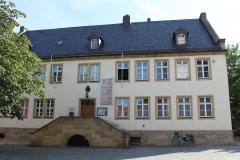
Since 1990, the town museum is located in the former school house (established in 1856). It displays archaeological finds from Staffelberg mountain, documents on the town’s development, testimonies of faith, minerals and fossils from the Franconian Jura region and the development of the Obermain Therme thermal baths. There is a separate section dedicated to the master of arithmetic, Adam Ries(e). On the top floor, there is a section titled “Victor von Scheffel – Dichter und Denk-Mal“, remembering the creator of the Song of Franconia. The remains of the 1000-year-old linden tree which once stood in the graveyard can now be found here and tell an exciting story.
Office of Agriculture
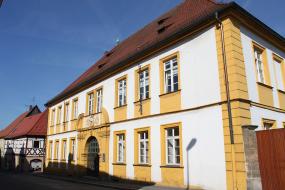
The former district offices of the Bamberg cathedral chapter were established between 1717 and 1720 according to the plans drawn up by Bamberg council member and town master builder Johann Friedrich Rosenzweig senior, and built by master mason Johann König. In 1830, the town acquired the building and donated it in 1862 to the Bavarian State to be used as the home of the newly-created district offices. Up until 1972, Staffelstein was the district capital.
The arched doorway is decorated with three coats of arms: in the middle, the coat of arms of the Bamberg cathedral chapter (the half-length figure of an Emperor); to the left, the coat of arms of the cathedral curator, Jobst Bernhard von Aufseß; and to the right, the coat of arms of the cathedral deacon Reinhard Anton von Eyb. Today, the building is used by the office of agriculture.
St. George Chapel
Digression: Next to the town pharmacy, there is a side street which leads to a small square, the Kastenhof, so named after the official residence (no longer there) of the cathedral chapter grainger, who received and stored taxpayer contributions in kind. This is where the St. George Chapel stands, first mentioned in 1401. After the chapel was destroyed in the 1684 town fire, it was only rebuilt in 1728, led by the local master builder Johann König. In comparison to its modest and undecorated façade, the interior of the chapel surprises visitors with its sophisticated baroque furnishings. The high altar depicts the church patron St. George.
St. Anna Chapel
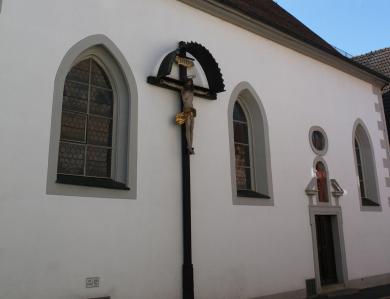
The Anna Chapel was erected in the 1430s as a Corpus-Christi chapel. In 1684 it shared the fate of the town and part of it was destroyed. The miraculous preservation of the wooden portrait of Anna in the cellar led to a strong upturn in the honouring of Anna in Bad Staffelstein. The stonemason Johann Finkel rebuilt the chapel between 1690 and 1694.
Town Tower

The town tower, also known as Bamberg Gate, is the most significant remainder of the fortifications which once surrounded the town and the only remaining tower out of the four which once stood. It took on its present form in 1573 thanks to Bamberg master builder Jakob Wolff; in around 1760 the curved garret was added. Parts of the town wall, often built over by houses, still remain. The “Alte Darre” (old kiln) where the malt for the town brewery was prepared, is connected to the town tower. Today it is the home of the town’s cultural initiative “Kulturinitiative Bad Staffelstein”.
Outside of the Former Town Walls:
Holy Cross Chapel

Digression: The Cross chapel on Bamberger Straße was erected in its current form in 1677/78 by the master builder of Rosenberg Fortress near Kronach. In 1956, the early baroque high altar was replaced with a flat stone altar with a crucifixion group. The chapel crucifix was created by sculptor Georg Bauer from Bamberg. The depiction of the sorrowful Virgin Mary comes from the 17 th century. A little further along the road from the town, you can see the crucifixion group on the right-hand side. It was part of the abandoned infirmary (housing for the terminally ill) and stood on the way to the gallows. The crucifix of the group we see today may be a piece from the 19 th century. Mary and John are from 1905.
Evangelical-Lutheran Church

Digression: The Evangelical-Lutheran Parish Church of the Holy Trinity was built between 1955 and 1957 on a triangular plot following the plans of Prof Karl Pfeiffer-Haardt from Bayreuth. The main door depicts a stone relief of the baptism of Christ and the holy trinity.
Adam Riese Hall
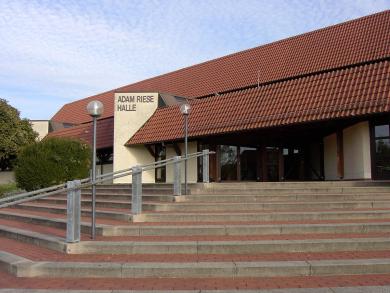
The Adam Riese Hall, built 1981–1983, is a multi-purpose hall where almost 600 spectators can watch almost any indoor sports. For cultural events, the hall has room for around 1000 people.
Obermain Therme Thermal Baths

A new chapter in Bad Staffelstein’s history began in 1975 when hot, salty and mineral-rich water was found at a depth of around 1600m. The Obermain Therme – thermal baths – Bavaria’s hottest and strongest thermal salt water spa – was opened in January 1986. At a second, 1180m deep drilling in 1993 a second thermal salt water source was discovered. Since 1986, the Obermain Therme has been continually expanded and modernized. It enjoys great popularity today and is one of the most frequented thermal spas in Bavaria. The state recognition as a health spa was awarded on 15 November 2001: Staffelstein became Bad Staffelstein.
Spa Park
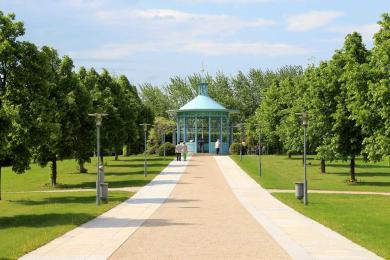
The spa park, opened in 1999, invites you to stay and relax next to the Obermain Therme. The central place for a wide range of cultural events is the lake stage. A special attraction of the park is the double-winged graduation house with an arbour, which lets you breathe in intensive salt air. Next to the viewing pavilion and a large fountain is the bridge theatre, the venue for the performances of the Franconian Theatre Summer festival. In the “ring of sculptures”, life-size bronze figures from Franconian sculptor Prof Wilhelm Uhlig invite you to take an “artistic stroll”.
Sculpture Walk
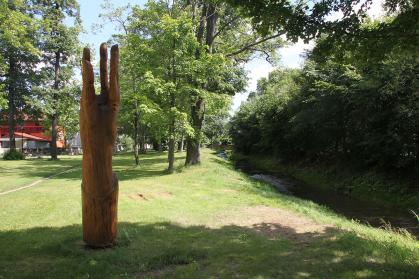
The town’s meadow and green belt connecting the town centre and the spa resort is lined with ten sculptures created by local artists. Along this route are numerous benches where you can quietly sit and relax.


